A uniform thin cylindrical disc of mass and radius is attached to two identical massless springs of spring constant which are fixed to the wall as shown in Fig. The springs are attached to the axle of the disk symmetrically on either side at a distance d from its centre. The axle is massless and both the springs and the axle are in horizontal plane. The unstretched length of each spring is . The disc is initially at its equilibrium position with its centre of mass () at a distance from the wall. The disc rolls without slipping with velocity . The coefficient of friction is .
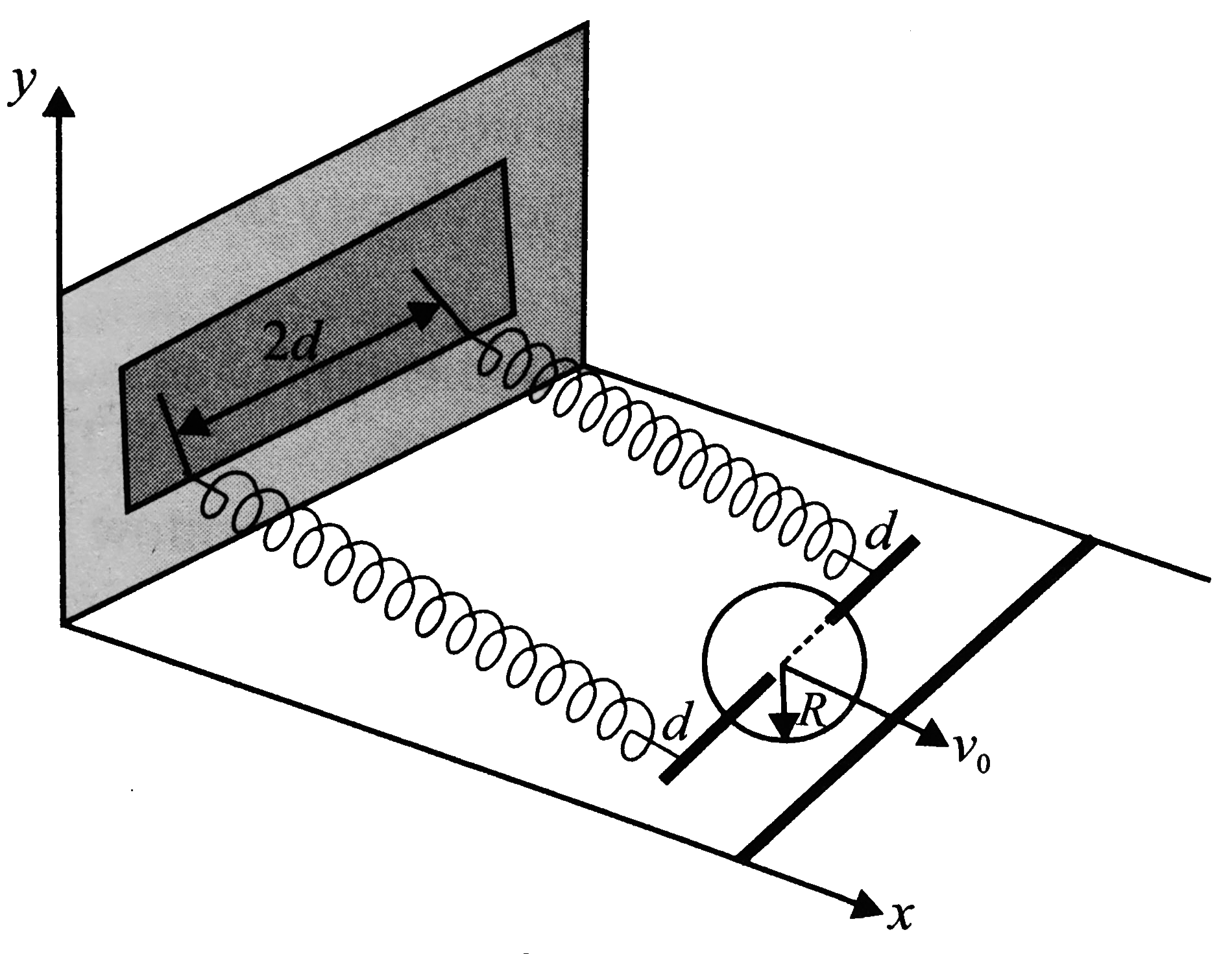
The net external force acting on the disc when its centre of mass is at displacement with respect to its equilibrium position is
The correct Answer is:D
Applying equation of torque about lowest point
as there is no slipping
Net force
Which is directed opposite to displacement
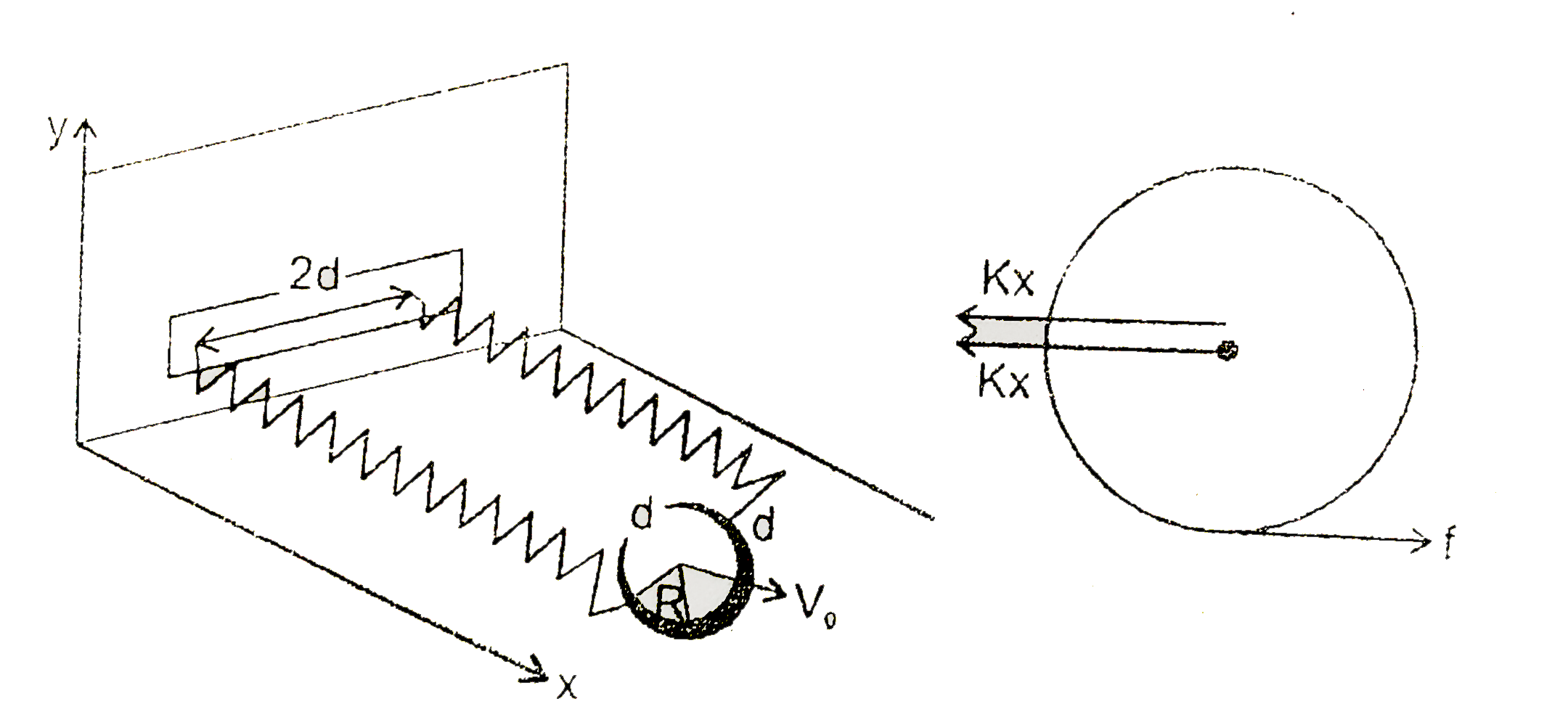
Topper's Solved these Questions
- SIMPLE HARMONIC MOTION Book:RESONANCE ENGLISHChapter:SIMPLE HARMONIC MOTION Exercise:Exercise- 3, PART - II
Explore 17 Videos
- SIMPLE HARMONIC MOTION Book:RESONANCE ENGLISHChapter:SIMPLE HARMONIC MOTION Exercise:Advanced Level Problems
Explore 13 Videos
- SIMPLE HARMONIC MOTION Book:RESONANCE ENGLISHChapter:SIMPLE HARMONIC MOTION Exercise:Exercise- 2, PART - IV
Explore 8 Videos
- SEMICONDUCTORSBook:RESONANCE ENGLISHChapter:SEMICONDUCTORSExercise:Exercise 3
Explore 88 Videos
- TEST PAPERSBook:RESONANCE ENGLISHChapter:TEST PAPERSExercise:PHYSICS
Explore 784 Videos
Similar Questions
If a simple harmonic motion is represented by d2xdt2+αx=0, its time period is
View SolutionA block of mass M1 is constrained to move along with a moveable pulley of mass M2 which is connected to a sprin of force constant k, as shown in the figure. If the mass of the fixed pulley is negligible and friction is absent everywhere, then the period of small oscillations of the system is
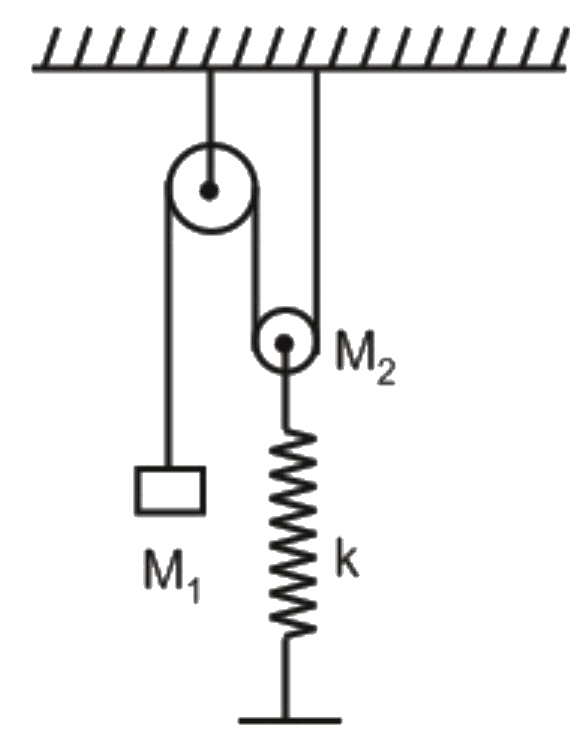
View SolutionA 2kg block hangs without vibrating at the bottom end of a spring with a force constant of 400N/m. The top end of the spring is attached to the ceiling of an elevator car. The car is rising with an upward acceleration of 5m/s2 when the acceleration suddenly ceases at time t=0 and the car moves upward with constant speed (g=10m/s2)
What is the angular frequencyof the block after the acceleration ceases ?
View SolutionWhen p−n junction diode is forward biased, then
View SolutionTwo particles are intially at a separation of d to each other. They move with constant velocirties with 5m/s and 3m/s respectively in horizontal plane. Their velocities makes an angle 60∘ with each other. If after 2 seconds, they collide. Then value of d is:
View SolutionA uniform thin cylindrical disk of mass M and radius R is attaached to two identical massless springs of spring constatn k which are fixed to the wall as shown in the figure. The springs are attached to the axle of the disk symmetrically on either side at a distance d from its centre. The axle is massless and both the springs and the axle are in horizontal plane. the unstretched length of each spring is L. The disk is initially at its equilibrium position with its centre of mass (CM) at a distance L from the wall. The disk rolls without slipping with velocity vecV_0 = vacV_0hati. The coefficinet of friction is mu. The net external force acting on the disk when its centre of mass is at displacement x with respect to its equilibrium position is.
View SolutionA uniform thin cylindrical disk of mass M and radius R is attaached to two identical massless springs of spring constatn k which are fixed to the wall as shown in the figure. The springs are attached to the axle of the disk symmetrically on either side at a distance d from its centre. The axle is massless and both the springs and the axle are in horizontal plane. the unstretched length of each spring is L. The disk is initially at its equilibrium position with its centre of mass (CM) at a distance L from the wall. The disk rolls without slipping with velocity vecV_0 = vacV_0hati. The coefficinet of friction is mu. The centre of mass of the disk undergoes simple harmonic motion with angular frequency omega equal to -
View SolutionA uniform thin cylindrical disk of mass M and radius R is attaached to two identical massless springs of spring constatn k which are fixed to the wall as shown in the figure. The springs are attached to the axle of the disk symmetrically on either side at a distance d from its centre. The axle is massless and both the springs and the axle are in horizontal plane. the unstretched length of each spring is L. The disk is initially at its equilibrium position with its centre of mass (CM) at a distance L from the wall. The disk rolls without slipping with velocity vecV_0 = vacV_0hati. The coefficinet of friction is mu. The maximum value of V_0 for whic the disk will roll without slipping is-
View SolutionOn a smooth inclined plane, a body of mass M is attached between two springs. The other ends of the springs are fixed to firm supports. If each spring has force constant K , the period of oscillation of the body (assuming the springs as massless) is
View SolutionOn a smooth inclined plane a body of mass M is attached between two springs. The other ends of the springs are fixed to firm supports. If each spring has a force constant k, the period of oscilation of the body is (assuming the spring as massless)
View Solutionदीवार पर जड़े स्प्रिंग नियतांक k वाले दो समरूप स्प्रिंगों से R त्रिज्या व M द्रव्यमान वाले बेलनाकार चकती चित्रानुसार जुड़ी है। दोनों स्प्रिंगे बेलनाकार चकती के केंद्र से d दूरी पर स्थित एक्सल के दोनों ओर जुड़े हैं। एक्सल तथा स्प्रिंग क्षैतिज तल में है तथा एक्सल भारहीन है। प्रत्येक स्प्रिंग की लम्बाई L है। साम्यावस्था में चकती का द्रव्यमान केंद्र दीवार से L दूरी पर है। चकती बिना फिसले v0=v0ˆi से लुढ़कती है तब घर्षण गुणांक μ है। चकती पर कार्य करने वाला परिणामी बाह्य बल, जबकि चकती का द्रव्यमान केंद्र माध्य स्थिति से x दूरी पर होगा-
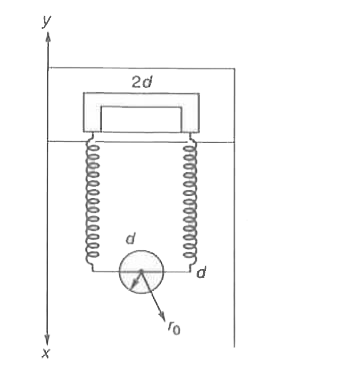
View Solutionदीवार पर जड़े स्पिरंग नियतांक k वाले दो समरूप स्पि्रंगों से R त्रिज्या व M द्रव्यमान वाले बेलनाकार चकती चित्रानुसार जुड़ी है। दोनों स्पि्रंगें बेलनाकार चकती के केंद्र से d दूरी पर स्थित एक्सल के दोनों ओर जुड़े हैं। एक्सल तथा स्पि्रंग क्षेतिज तल में है तथा एक्सल भारहीन है। प्रत्येक स्पि्रंग की लम्बाई L है। साम्यावस्था में चकती का दव्यमान केंद्र दीवार से L दूरी पर है। चकती बिना फिसले v0=v0ˆi से लुढ़कती है तब घर्षण गुणांक μ है।
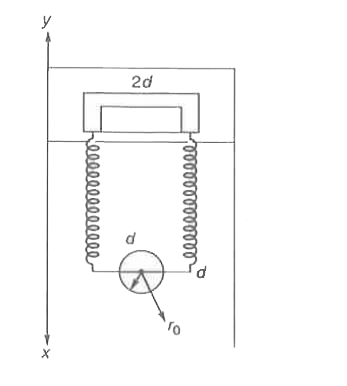
सरल आवर्त गति करती हुई चकती के द्रव्यमान केंद्र की कोणीय आवृत्ति ω का मान होगा
View Solutionदीवार पर जड़े स्पिरंग नियतांक k वाले दो समरूप स्पि्रंगों से R त्रिज्या व M द्रव्यमान वाले बेलनाकार चकती चित्रानुसार जुड़ी है। दोनों स्पि्रंगें बेलनाकार चकती के केंद्र से d दूरी पर स्थित एक्सल के दोनों ओर जुड़े हैं। एक्सल तथा स्पि्रंग क्षेतिज तल में है तथा एक्सल भारहीन है। प्रत्येक स्पि्रंग की लम्बाई L है। साम्यावस्था में चकती का दव्यमान केंद्र दीवार से L दूरी पर है। चकती बिना फिसले v0=v0ˆi से लुढ़कती है तब घर्षण गुणांक μ है।
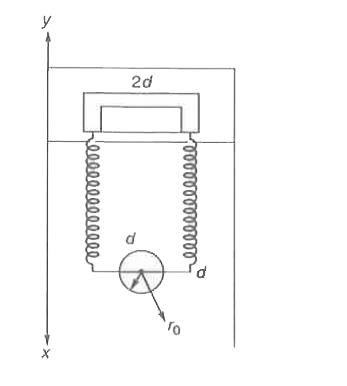
v0 का वह अधिकतम मान जिसके लिए चकती बिना फिसले लुढ़क जाएगी, है
View SolutionA disc of mass M and radius R has a spring of constant k attached to its center , the other end of the spring being fixed to a vertical wall. If the disk rolls without slipping on a level floor, how far to the right does the centre of mass move , if Initially the spring was unstretched and the angular speed of the disc was omega_0
View SolutionOn a smooth inclined plane, a body of mass M is attached between two springs. The other ends of the springs are fixed to firm supports. If each spring has force constant K, the period of oscillation of the body (assuming the springs as massless) is :
View SolutionOn a smooth inclined plane, a body of mass M is attached between two springs. The other ends of the springs are fixed to firm supports. If each spring has force constant K , the period of oscillation of the body (assuming the springs as massless) is
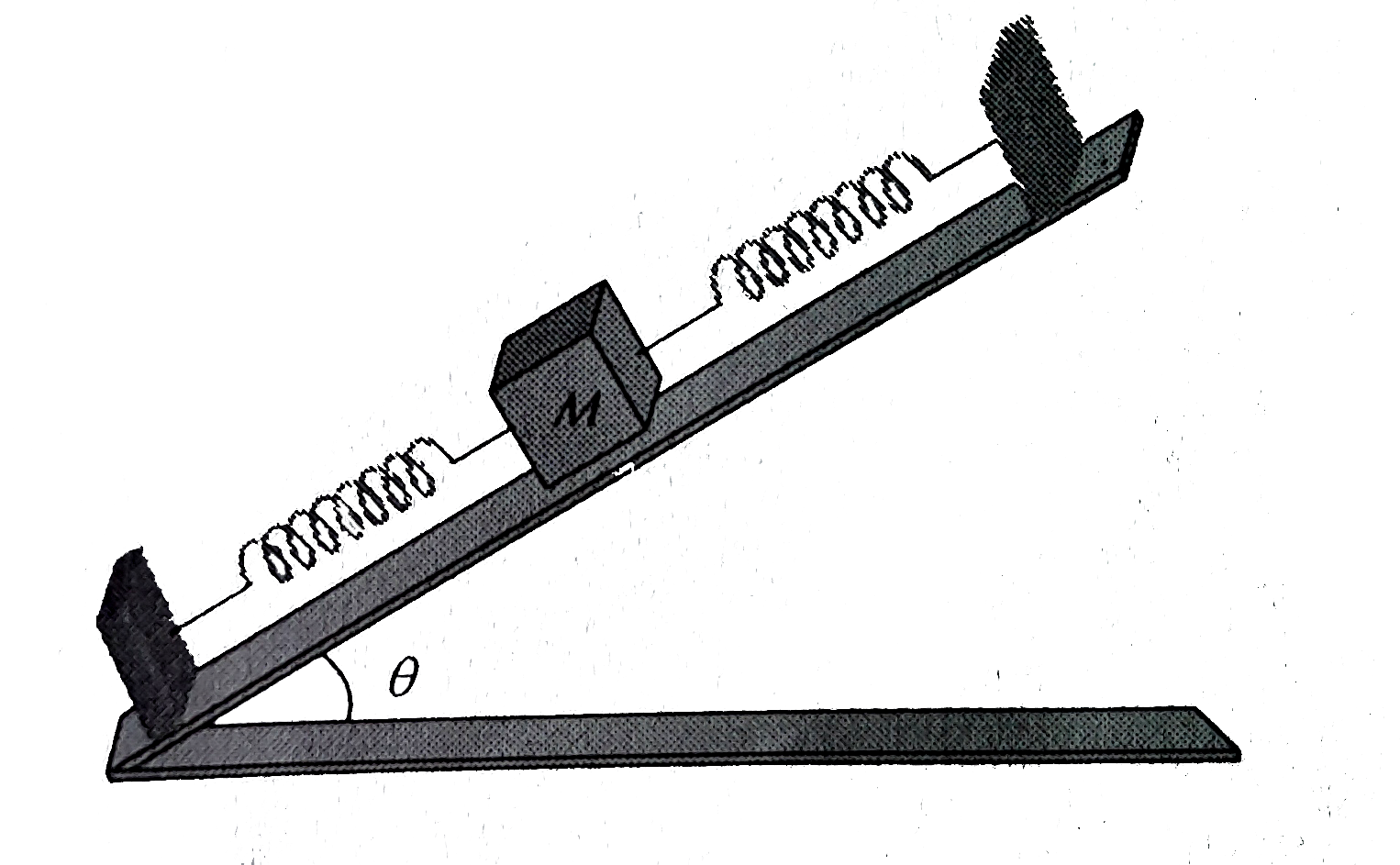
View Solution